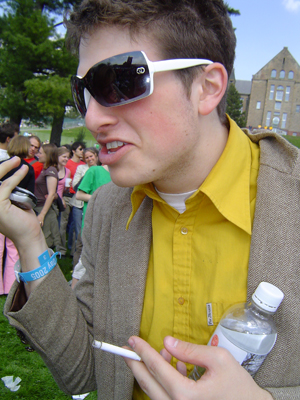Over a three year period, an ethnographic survey of youth subcultures was conducted in Ithaca NY by Prof. Van Dyk Lewis and a team of student researchers. The intention was to map these subcultural communities, examine their ideas of fashion and the specifics of each subcultural style. At the end of the three year study, the Cornell Costume and Textile Collection became involved in the project, organizing an effort to collect examples of street fashion as created by the subject s of this study, as a method of documenting self-fashioned youth subcultures of the present day through collection of their dress as ethnographic costume. One of the outcomes of this research was a video on street style and fashion in youth subcultures.
The rationale behind this study is twofold: the first aim endeavors to grasp a richer understanding of where youth subcultures exist in the fashion system, the social forces behind their fashion expression, and how their fashions are created, presented, manipulated, updated and ultimately expressed both within and across social groups. The second aim is to build upon an existing ethnographic collection of costume through the acquisition of current youth sub-cultural fashion ensembles, thus preserving physical evidence of this social history for the future. These items have become part of the Costume Collection at Cornell University. This website, still under construction, is being developed to exhibit the results of these efforts.
Recent history is proof that past youth subcultures have influenced mainstream fashion, and today’s youth subcultures are on the forefront of fashion change and experimentation. High-end designer clothing, beautiful couture garments, and the outfits of celebrities will most certainly be remembered and preserved for the future, but these are not fully accurate representations of current society and youth culture, nor are they a full representation of the sources of fashion invention. The collection and preservation of the actual garments and accessories belonging to youth subcultures, as opposed to the later knock-offs of these styles that are more commonly found in costume collections, will provide a substantial and meaningful documentation of youth society and its effect on mass fashion.
Prior to collecting subcultural fashion pieces, two years were devoted to ethnographic fieldwork in order to study five different self-fashioned youth subcultures in a semi-rural college town. During the two-year study period, five undergraduate students and one graduate student, together with a faculty research leader, were actively engaged in fieldwork. The ethnographic methodology applied relied upon participant observation research and social immersion. Findings were documented by photography, interviews, written notes and eventually through acquisition of fashion pieces.
Regarding ethnographic fieldwork, Timothy Jenkins argues, “fieldwork is an apprenticeship… a process of entry into a particular world.” (Jenkins 1994: 445) The researchers embraced Timothy Jenkins’ notion of the anthropologist as apprentice, and after a short time, began apprenticing themselves to particular sub-cultures. In order to participate and embed within a subculture, researchers created their own self-fashioned subcultural personas. The process of collecting, acquiring, arranging and ultimately testing these contrived visual guises was as much ethnography as curatorial work.
Following these fieldwork endeavors, the research began a new phase. Denise Green, then a senior in Apparel Design both working with Prof. Lewis' project and also as a Collection Assistant with Prof. Charlotte Jirousek in the Costume Collection, began collecting garments and accessories via donations from members of the various subcultures. These pieces was eventually organized into an exhibition and the collection now remains in the university Costume Collection as ethnographic documentation of early twenty-first century youth subcultures (Also see costume collection online catalog). She also created a documentary film on the project, which is also available on this website.
The initial ethnographic research provided a foundation of knowledge upon which an accurate and comprehensive collection of garments and accessories documenting youth subcultural fashion expressions may be built. The effort to add to this collection is ongoing. It is also felt that this is a project that would be very fruitful as an undertaking for faculty/student teams in other communities, documenting the roots of fashion in street style in various regions of the country.
|
   |
|






